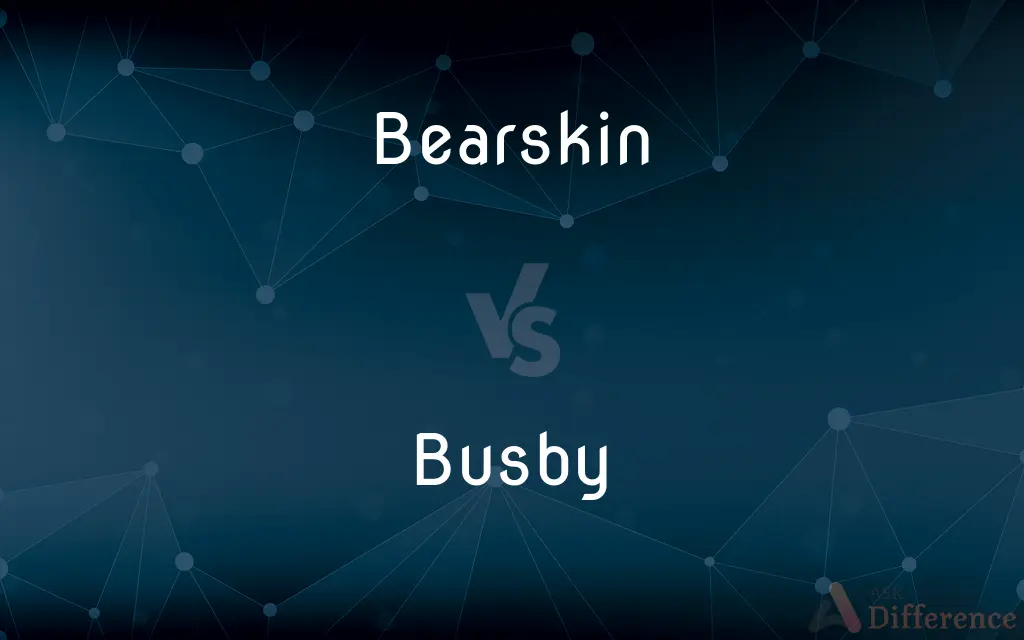Bearskin vs. Busby — What's the Difference?
By Tayyaba Rehman — Updated on September 25, 2023
"Bearskin" is a tall fur cap, traditionally worn by certain regiments of the military; "Busby" is a similar, but usually smaller, fur hat, often worn by hussars and artillerymen.

Difference Between Bearskin and Busby
Table of Contents
ADVERTISEMENT
Key Differences
"Bearskin" and "Busby" both refer to distinctive types of military headgear, yet they differ in terms of size, origin, and specific use. A bearskin is a tall, fur cap, usually made from the pelt of a bear, traditionally worn by grenadiers and recognized for its imposing height and ceremonial significance. It is often associated with prestigious and historic regiments and serves as a symbol of honor and tradition. The imposing height of the bearskin is intended to make the soldier appear taller and more formidable.
Conversely, a busby is a smaller, fur hat, often associated with hussars and artillerymen. While it also holds ceremonial importance, its design is more compact and its association more varied, spanning different branches of the military. The busby may be made of different types of fur and is characterized by its rigidity and cylindrical or conical shape.
A bearskin is notable for its significant height, often extending well above the wearer's head, giving an imposing appearance in military parades and ceremonies. It is deeply ingrained in military heritage, particularly within certain regiments, symbolizing valor and tradition.
In comparison, a busby, with its smaller and more rigid structure, serves a similar ceremonial role but does not carry the same level of imposing visual impact as the bearskin. It is, however, equally rich in tradition and history, symbolizing distinct military identities and values within different regiments and branches.
In essence, while both the bearskin and the busby are iconic pieces of military headgear with rich histories and symbolic importance, they differ primarily in size, design, and the specific military branches and regiments with which they are associated.
ADVERTISEMENT
Comparison Chart
Size
Typically taller
Generally smaller and more compact
Associated Branches
Often associated with grenadiers
Usually worn by hussars and artillerymen
Design
Made from the pelt of a bear, imposing height
Rigid, cylindrical or conical, made of various furs
Symbolism
Symbolizes valor and tradition in specific regiments
Represents distinct military identities and traditions
Usage
Primarily ceremonial, used in parades and official events
Worn for ceremonial purposes and official functions
Compare with Definitions
Bearskin
A ceremonial headgear used predominantly in parades.
Soldiers wearing bearskins are a common sight during state ceremonies.
Busby
A small, rigid, military fur hat.
The artilleryman wore a busby as part of his ceremonial uniform.
Bearskin
A high, military fur hat, symbolizing tradition and valor.
The bearskin is usually worn with full ceremonial uniform.
Busby
A cylindrical or conical fur cap, associated with hussars and artillerymen.
The busby is often adorned with a colored cloth and a plume.
Bearskin
A type of hat made traditionally from the fur of a bear.
The bearskin is considered a symbol of honor in some regiments.
Busby
A compact, traditionally fur-made hat with a distinct shape.
The rigid structure of the busby differentiates it from other military hats.
Bearskin
An iconic piece of military headgear with significant height.
The impressive height of the bearskin makes the wearer appear more formidable.
Busby
A piece of headgear worn for ceremonial purposes in the military.
A busby is as rich in tradition as it is distinctive in appearance.
Bearskin
A tall fur cap worn by certain military regiments.
The guard stood stoically, his tall bearskin adding to his imposing presence.
Busby
A military hat, symbolizing distinct identities within different branches.
The busby holds significant importance in representing regimental pride and history.
Bearskin
A bearskin is a tall fur cap, usually worn as part of a ceremonial military uniform. Traditionally, the bearskin was the headgear of grenadiers and remains in use by grenadier and guards regiments in various armies.
Busby
A full-dress fur hat of varying shape, worn by hussars in the 19th century and by certain regiments of the British army.
Bearskin
Something, such as a rug, made from the skin of a bear.
Busby
A fur hat, usually with a plume in the front, worn by certain members of the military or brass bands.
Bearskin
A tall military hat made of black fur.
Busby
A military headdress or cap, used in the British army. It is of fur, with a bag, of the same color as the facings of the regiment, hanging from the top over the right shoulder.
Bearskin
The pelt of a bear, especially when used as a rug.
Busby
Tall hat; worn by some British soldiers on ceremonial occasions
Bearskin
A tall ceremonial hat worn by members of some British regiments for ceremonial occasions; a busby.
Bearskin
(dated) A coarse, shaggy, woollen cloth for overcoats.
Bearskin
The skin of a bear.
Bearskin
A coarse, shaggy, woolen cloth for overcoats.
Bearskin
A cap made of bearskin, esp. one worn by soldiers.
Bearskin
The pelt of a bear (sometimes used as a rug)
Bearskin
Tall hat; worn by some British soldiers on ceremonial occasions
Common Curiosities
Is wearing a bearskin restricted to specific regiments?
Typically, yes, wearing a bearskin is often a tradition within specific military regiments.
Is a busby only worn for ceremonial purposes?
Predominantly, yes, a busby is generally worn for ceremonial purposes and official functions.
How is a busby different in design from a bearskin?
A busby is generally smaller, more compact, and has a rigid, cylindrical or conical shape, whereas a bearskin is notably taller.
Is a bearskin always made from bear fur?
Traditionally, yes, but modern versions might use synthetic materials or other furs to adhere to ethical standards.
Does wearing a bearskin have a practical purpose?
The primary purpose of a bearskin is ceremonial and symbolic, with its practicality being limited.
Is the busby comfortable to wear?
Comfort can be subjective, but due to its rigid design, a busby might not be as comfortable as softer, more flexible hats.
How is the fur for a bearskin sourced ethically?
Ethical sourcing involves using synthetic fur or acquiring fur through legal and sustainable means, ensuring animal welfare.
Can a busby be adorned with additional decorations?
Yes, busbies are often adorned with colored cloths, plumes, or other regimental insignia.
Can a busby be made from bear fur?
Yes, a busby can be made from various furs, including bear fur.
Is the bearskin worn throughout the year?
The bearskin is predominantly worn during specific events, ceremonies, and parades, regardless of seasons.
Can a bearskin be worn by non-military personnel?
Generally, no, as it is a distinctive piece of military uniform, but replicas might be worn in civilian settings for costume or theatrical purposes.
Can a civilian own a bearskin?
While typically part of military uniform, civilians might own replicas or vintage bearskins as collectibles or for theatrical use.
Can women in the military wear a busby?
Yes, women in the military can wear a busby if it is part of the prescribed uniform for their regiment or unit.
Is maintaining a bearskin difficult?
Maintenance can be meticulous, involving careful cleaning and storage to preserve the fur and shape.
Is a busby synonymous with any other military hats?
A busby might be similar to other fur military hats but is distinct in its design and association with specific military branches.
Share Your Discovery

Previous Comparison
Wash vs. Rinse
Next Comparison
Satguru vs. SadguruAuthor Spotlight
Written by
Tayyaba RehmanTayyaba Rehman is a distinguished writer, currently serving as a primary contributor to askdifference.com. As a researcher in semantics and etymology, Tayyaba's passion for the complexity of languages and their distinctions has found a perfect home on the platform. Tayyaba delves into the intricacies of language, distinguishing between commonly confused words and phrases, thereby providing clarity for readers worldwide.















































